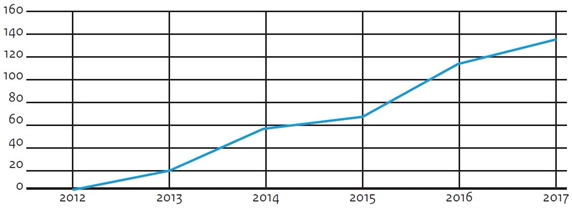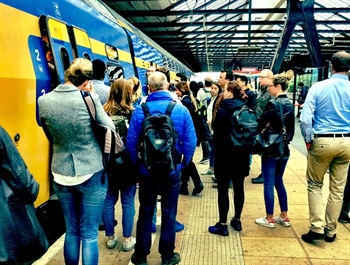Case study Rush-hour avoidance on public transport using MyOV
NS trains are becoming increasingly crowded, especially during the rush-hour. In order to distribute passengers more evenly, NS launched the MyOV app in August 2016. By using this app, passengers who normally travel on busy trains at peak times can save points by choosing alternative, less busy trains. NS checks this by means of travel history.
MyOV is an app that encourages passengers to extend the rush-hour. To participate, passengers must download the app and log in with an OV-smart card account. Passengers can earn points by choosing less busy trains and earn gifts. MyOV is now being used on all routes to and from Utrecht Central Station, on the IC-Direct between Rotterdam and Schiphol and on the Zwolle-Groningen route. NS launches a communication campaign when adding new routes and refers passengers to MyOV via newsletters and flyers, among other things.

(Source: Thijs van Daalen)
The app shows participants how many points they have earned. These points are calculated using the app, which displays travel history based on the public transport smart card account. Passengers who had already shown the desired behaviour before they started using MyOV will also be rewarded. The distribution of points is based on a number of principles and is the same for every route:
- 10 points at night and on weekends for all trains on MyOV routes
- 30 points for all trains on MyOV routes during off-peak times (rush-hour avoidance)
- 0 points for very busy trains and 90 or 200 points for less busy alternative trains (if a train is an alternative to a busy 0 points train) during the rush-hour
Less busy trains during peak hours are therefore rewarded more than trains during off-peak hours, because MyOV is specifically used for evening out the hustle and bustle during rush-hour; more so than for rush-hour avoidance. For more information on the costs and impact of various rush-hour avoidance measures on public transport, see the fact sheet Rush-hour avoidance on public transport.
Implementation
In order to distribute passengers more evenly during rush-hour, NS launched the MyOV app in August 2016. MyOV has already been used on Arriva trains in the north of the Netherlands. Because the app already existed, it could quickly be used on a number of test routes in Utrecht. Since 2016, NS has added various routes to MyOV. Because participants opt for less crowded trains, not only do they have a better chance of finding a seat, but the train they would otherwise take is also less full.
56% of MyOV participants travelled less on crowded trains during the rush-hour. The effectiveness of MyOV for NS was not measured against predetermined quantitative targets. The main aim was to learn from the effects of MyOV. MyOV’s costs and benefits were examined, compared to the procurement and deployment of additional trains and the deployment of buses. NS pays a fixed monthly amount for use of the MyOV app. Furthermore, NS pays an amount for the points that participants earn.
The greater the number of participants who have MyOV, the cheaper the costs per transfer of train journey will be. In April 2017 the cost per rush-hour train avoided was €2.52. A survey shows that almost three quarters of the participants are satisfied or very satisfied with MyOV. Up to and including December 2017, there were almost 63,000 transfers to other trains. That is not to say that this also provided as many seats in crowded trains. It is unknown whether the passengers who transferred their journey to another train would have had to stand or could have sat on the crowded train.

Results
MyOV started as an initiative of the former Ministry of Infrastructure and the Environment, the provinces of Groningen, Friesland, Drenthe and Overijssel and transport company Arriva (within the framework of the Optimising Use programme). The app is provided by Data-Lab; they manage the app, the travel data and the customer data and provide customer service. NS is now deploying the app on the busy routes.
In addition to the deployment of MyOV, NS is also working more widely to raise awareness of crowded trains. This is achieved, for example, by indicating the expected volume of passengers in the NS app. And NS is also offering cheaper off-peak fares to people who avoid rush-hour travel. In addition, NS is continuously working on optimising the use of its equipment.
Considerations for deployment elsewhere
NS is enthusiastic about MyOV and the principle of rush-hour avoidance and extending the rush-hour, but does see some areas for improvement:
- The possibility of being able to reward people on a more personal basis. People who have 'genuinely’ opted to transfer their journey to a time outside rush-hour travel must primarily be rewarded. More personal travel advice is also part of this.
- Improvements to registration. MyOV now requires an OV-smart card account. People often don’t have such an account, can’t remember the password or don’t feel like looking it up.
- It is important to look closely at the target group: who needs to get active? Anyone can register with MyOV, but some participants do not travel at peak times or on a MyOV route anyway. This may weaken the desired effect.
- MyOV is very labour-intensive, because the number of points that can be earned on a train journey is determined manually. This has to be updated each time the timetable changes.
NS would like to continue with methods of rush-hour avoidance and extending the rush-hour and is currently looking into which approach is appropriate. Pilot projects are under way to test and evaluate the impact of various (behavioural) measures in practice.

